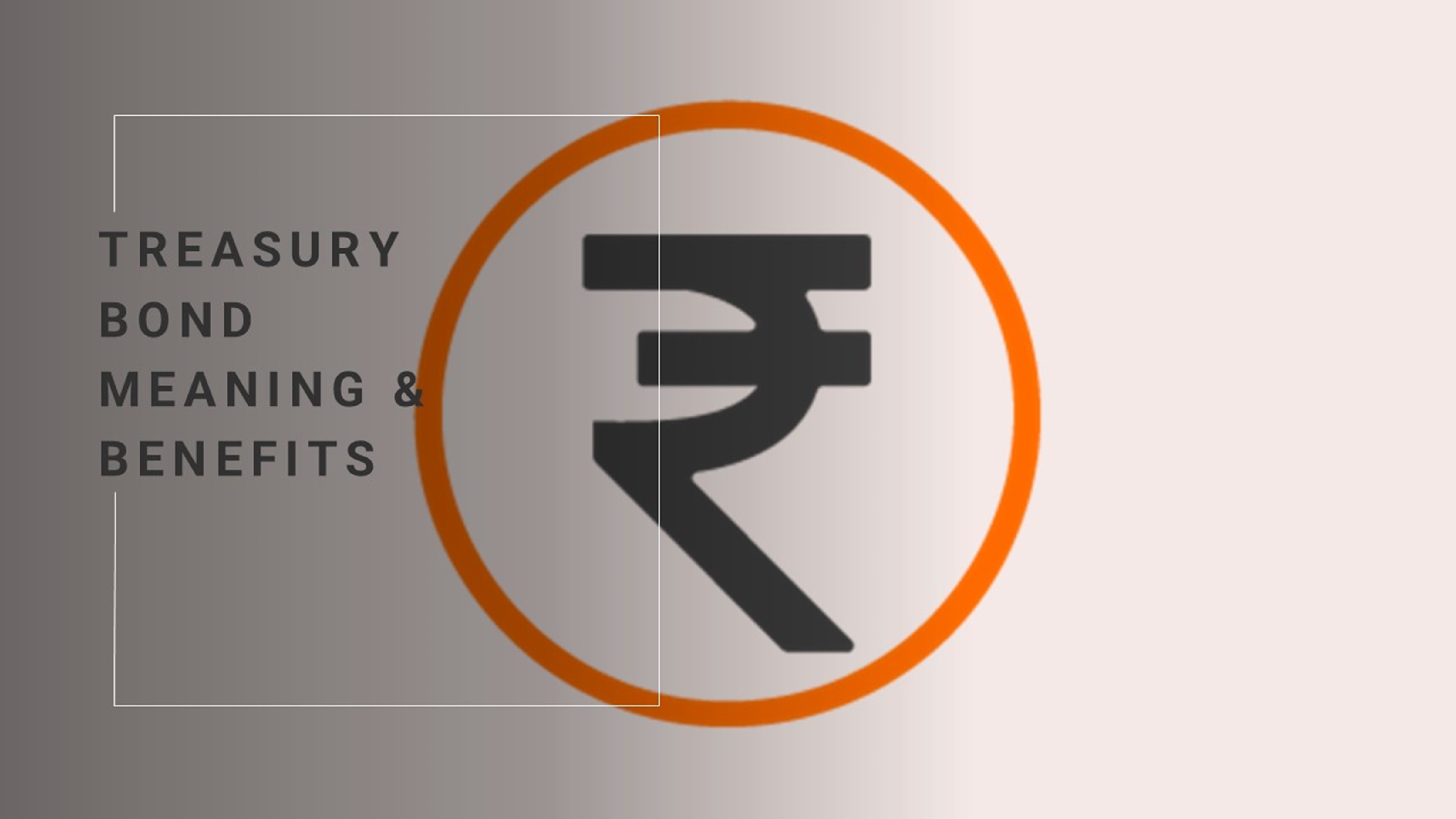Treasury Bond Meaning & Benefits | How to Invest

Imagine a business with steady operations and dependable clients. Every month, bills need to be paid on time, new inventory must be sourced, and there’s always a need for ready funds. Unexpected expenses can create cash flow gaps, and the owner seeks a reliable way to manage these challenges without worrying about market swings or risk.
This is where the idea of investing in bonds, particularly Treasury Bonds, becomes relevant. Treasury Bonds stand out as a particularly secure and accessible option for both businesses and individual investors aiming to balance risk and return.
What is a Treasury Bond?
Treasury Bond meaning is simple; it is a long-term debt security issued by the government to raise funds for public spending and projects. When you buy a Treasury Bond, you are lending money to the government. In return, the government agrees to pay you a fixed rate of interest, called the coupon rate, at regular intervals (usually every six months) and return the full principal, or face value, on a specified maturity date, which can range from 10 to 30 years. Treasury Bonds are considered one of the safest investments because they are backed by the government’s ability to tax and print money, making the risk of default extremely low.
Key Features of Treasury Bonds
Treasury bonds offer a unique blend of safety, stability, and simplicity for investors seeking to preserve capital while earning predictable returns, thanks to their government backing and clear, long-term structure.
- Issuer: Government
- Maturity: Long-term, typically 10, 20, or 30 years.
- Interest: Fixed coupon rate, paid semiannually.
- Principal: Returned in full at maturity.
- Risk: Very low, backed by government credit.
- Marketability: Can be bought and sold in the secondary market before maturity.
With their low risk, fixed income, and ease of trading, Treasury bonds are a foundational choice for anyone looking to build a resilient portfolio. Consider these benefits as you invest in bonds to achieve both security and peace of mind in your financial journey.
Types of Treasury Bonds (and Related Securities)
While “Treasury Bond” often refers specifically to long-term debt, government securities come in several forms, each with distinct features:
|
Type |
Maturity |
Interest Payment |
Notes |
|
Treasury Bills (T-bills) |
Up to 1 year |
No periodic interest |
Issued at a discount, redeemed at face value |
|
Treasury Notes (T-notes) |
2–10 years |
Semiannual interest |
Medium-term, stable returns |
|
Treasury Bonds (T-bonds) |
10–30 years |
Semiannual interest |
Long-term, fixed income, very low risk |
|
TIPS (Treasury Inflation-Protected Securities) |
5–30 years |
Semiannual interest, adjusted for inflation |
Protects purchasing power from inflation |
Why Invest in Treasury Bonds?
Treasury Bonds are a cornerstone of conservative investment strategies. Here’s why they might fit into your portfolio:
- Security: Backed by the government, Treasury Bonds are among the safest investments available, with virtually no credit risk.
- Predictable Income: The fixed coupon payments provide a steady, reliable income stream, which can be especially valuable for retirees or those seeking stability.
- Liquidity: Treasury Bonds are highly liquid. They can be sold in the secondary market before maturity if you need cash.
- Tax Advantages: Interest earned is often exempt from state and local taxes, though subject to federal income tax. This can improve after-tax returns, especially for investors in high-tax states.
- Portfolio Diversification: Adding Treasury Bonds can help balance riskier investments, such as stocks, and reduce overall portfolio volatility.
- Ease of Access: Government bonds are widely traded, and online platforms make buying and selling them straightforward.
Ultimately, why invest in Treasury bonds comes down to balancing safety, income, and liquidity, while simplifying portfolio management and ensuring peace of mind in both personal and business finances.
Understanding Treasury Bond Interest Rates
Treasury Bond interest rates, the coupon, are set at issuance and remain fixed for the life of the bond. The actual yield you receive depends on the purchase price you pay. If you buy a bond at face value, your yield equals the coupon rate. If you buy at a discount (below face value), your yield will be higher; if at a premium (above face value), your yield will be lower. Interest rates are influenced by overall economic conditions, inflation expectations, and central bank policy. Currently, rates for long-term Treasury Bonds are competitive.
Comparing Treasury Bonds with Other Investments
While Treasury Bonds are prized for safety, they typically offer lower returns than stocks or corporate bonds. However, this lower risk can be a strategic advantage, especially during periods of market uncertainty. Here’s a quick comparison:
- Stocks: Higher potential returns, but with greater risk and volatility.
- Corporate Bonds: Higher yields, but carry credit risk, the chance that the issuer might default.
- Bank Deposits: Safe, but often offer lower interest rates and less liquidity than bonds.
- Real Estate: Can appreciate, but is illiquid, requires maintenance, and is subject to market cycles.
Treasury Bonds sit at the safest end of this spectrum, making them ideal for those who prioritize capital preservation and steady income.
Who Should Consider Investing in Treasury Bonds?
Treasury Bonds are suitable for:
- Risk-averse investors seeking stability and the safety of principal.
- Retirees need a reliable income without exposure to stock market volatility.
- Businesses looking to park surplus funds with minimal risk and easy access.
- Portfolio managers aiming to diversify and reduce overall risk.
- First-time bond investors want to understand fixed income with minimal complexity.
How to Buy and Sell Treasury Bonds in India?
In India, government securities (GSec), including Treasury bills, are available through the Reserve Bank of India (RBI) via the Retail Direct Scheme or through Bondbazaar. Here’s how to invest in Treasury Bonds:
- Open a demat account and register on a SEBI-registered platform (Bondbazaar) or the RBI’s Retail Direct Scheme.
- Complete KYC and link your bank account.
- Buy bonds in primary auctions or the secondary market.
- Sell anytime; proceeds credited after T+2 settlement.
- Bonds held digitally; interest and principal paid directly.
- No charges on Bondbazaar; sovereign-backed security.
- Interest income is taxable; consult a tax advisor for guidance.
With over 10,000 bonds across categories, an automated digital platform, and a physical service team, Bondbazaar makes bond investing accessible, efficient, and transparent—whether you are a beginner or an experienced portfolio manager.
Conclusion
Whether you’re planning for retirement, your child’s education, or just want to balance a risky portfolio, investing in Treasury Bonds offers several key advantages. The benefits of Treasury Bonds include government backing with virtually no risk of default, steady and predictable income through fixed coupon payments, and lower portfolio volatility thanks to their stability. While returns may be modest, the peace of mind and financial assurance they provide are unmatched.
Ready to take control of your financial future? Start exploring Treasury Bonds on Bondbazaar today, open your account, discover the right instruments for your goals, and begin building a more secure, balanced portfolio with confidence. Take the first step toward smarter investing now.
